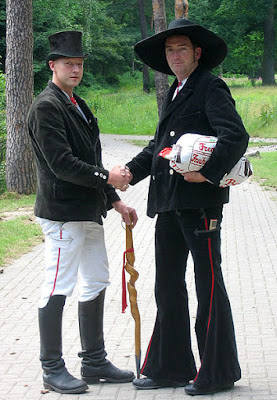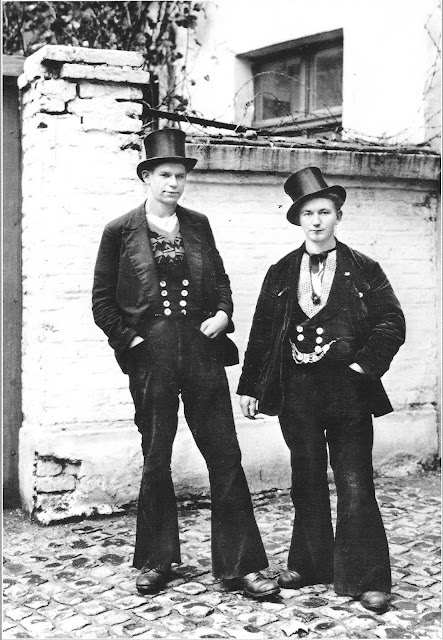(Image from 'The Mortice and Tenon, Spring 2013)
These are journeymen carpenters in Germany and the picture was taken in 1928 by August Sander. Journeymen carpenters still wear almost identical outfits today with justified pride and can be identified by them.
Some other trades, such as builders and metalworkers, also have a tradition of travelling journeymen. They often wear similar clothes to those of carpenters and may belong to the same travelling 'clubs'. Details such as the colour of the fabric and designs on the belt buckles will differ from those of woodworking trades. Some journeymen also wear different clothes to the ones shown above, such as breeches and knee-high boots.
 |
| Image by A.Stemmer from https://commons.wikimedia.org/wiki/File:Gesellen1.jpg |
If you'd like to see what happens when a travelling journeyman goes home, I've written about it in another post. Some join a guild or society and will usually follow it's strict code of conduct (Schacht).
Others do not join a particular group, but are free-journeymen. They also observe the same codes of conduct, but are not bound to attend meetings and to observe other obligations that members of a journeyman society might do.
(Image from www.flyingshavings.co.uk)
The carpenter journeymen of Germany are sometimes called 'Zimmermen' and can be easily recognised by the way that they dress and certain traditional objects that they carry. Like the two carpenters above, woodworking members of a 'guild' or club will often wear a black and white three-piece suit with, sometimes, an identifying tie. The blue ties worn by the two men above show that they are members of the 'Roland's Brothers' club, which was officially founded in 1891. The red ties worn by the men shaking hands in the photo above this one show that they are members of the 'Free Brothers' club, which was founded in 1910. These clubs are two of the older ones, the oldest and one of the most traditional of the clubs being the 'Righteous Brothers'. None of these clubs will admit female members.
A journal (Wanderbuch) is carried which the bearer must not fill in. Those that they work with will fill it with notes but the journeyman will collect stamps from officials (at post offices for example) to show where they have been.
They wear their hat (usually a black one) at all times when travelling and will carry a cloth bag holding their possessions and a cane (the Stenz) made from a twisted branch. I have seen photos of journeymen working in the baking heat of a workshop in Zanzibar but still wearing their black hats, black waistcoats and trousers. They are justly proud of what this dress code means and the tradition that they carry. Free journeymen will wear a white shirt with the collar tucked inside, but the rest of the outfit may be chosen at will.
The wide-brimmed hat (similar to that worn by the men on the right in the two photos immediately above) is usually worn by someone in their first year of travelling. The wide brim would come in useful if someone was working above you and generating sawdust, as it stopped the sawdust getting into your eyes. However, such a large hat can be a bit more difficult to travel with and so more experienced journeymen wear smaller hats, which are also much more practical.
If you look carefully at the left ear of the man on the right of the top photograph, you can just see a long earring hanging from it. This earring is called the Ohrhänger and is worn with pride, always in the left ear. Sometimes, it will show the tools associated with the wearer's craft. In the case of the carpenters, this could include tools that a carpenter uses - perhaps a pair of compasses, a saw, a carpenter's axe or a hewing axe. Other possible symbols include a hexagram (symbolising the geometry of carpentry) and two plumb bobs. One society, named Axt und Kelle, wear earrings showing an axe, a builder's trowel and the rising sun.
The earrings serve several purposes. They identify the wearer as a trained carpenter and they could be used in the worst case to pay for their funeral if they died whilst travelling. If the wearer should bring the guild into disrepute by bad workmanship or behaviour, the earring can be forcibly torn out leaving a jagged scar and identifying them as a Schlitzohr. How is the ear pierced for the earring? With a hammer, a nail, a block of wood and large amounts of alcohol of course.
Journeymen don't wear plastic buttons on their clothes. Instead, they are usually made from mother-of-pearl; a material with some value. These buttons could therefore be used in payment and as collateral if the wearer has no money.
In France, the Compagnons de devoir are trade guilds. They are also very old, dating back to medieval times, but have different traditions to the German ones. The two systems were apparently closer in form to each other before the French system was reformed in the 1950s. The French guilds teach around communal houses which are strictly governed by 'The Rule'. Like German guilds, high standards of moral and professional conduct are expected to be followed. Travel is also important in acquiring knowledge and skills.
It seems sad that in Britain, the tradition of the carpentry guilds has been lost to some extent. They were particularly important in medieval times as tradesmen would travel around Europe working on large building projects. However, in Britain the dissolution of the monasteries and the joyless actions of the puritans probably meant that work was too hard to find to sustain the guilds in the same way as those in mainland Europe.
There are the livery companies of carpenters, of turners and of joiners based in London, the 'Worshipful Companies', but their good work is mainly in helping trainees financially by awards rather than by networks and practical training. Of course, many guild journeymen from Europe still travel to the UK, like the two gentlemen in the more recent photo above, and the Carpenters' Fellowship has strong links to the carpenter's guilds in both France and Germany.
(Image from http://the189.com/design/art/constantin-brancusi-artist-and-sculptor/)
I was intrigued to read that some believe that Constantin Brancusi, one of the most influential sculptors of the twentieth century, came through a guild system. He left his home in Romania in 1904 and travelled to Paris but there is little record of him until he turned up there. Pierre Cabanne, in his book on Brancusi, believes that this journey may have seen the young woodworker helped and given shelter by the guild, which he could have been in contact with whilst studying and working in the town of Craiova. It's interesting to think that the ancient guild system in Europe could have profoundly influenced sculpture in this way even into the present day.
This is a very brief look at the European carpenter's guilds and their journeyman traditions. If you are interested, why not check out these sites:
There is a lot more about journeymen travelling in the German tradition on this blog post. It was written after hanging out with Nat and Leo, who were 'travelling in the tradition' at the time.
You can read more about German journeymen on Robin Wood's blog here:
http://greenwood-carving.blogspot.co.uk/2010/07/german-journeyman.html
There is also an interesting Wikipedia page about them:
http://en.wikipedia.org/wiki/Journeyman
There is information about the German and French guilds here:
http://www.en.charpentiers.culture.fr/thepeople/compagons/thecarpentersguildingermany
The Carpenter's Fellowship website can be found here:
http://www.carpentersfellowship.co.uk/





What a great article! The carpenter's outfit was mentioned in another article I was reading and I came upon your post looking it up. I never even knew journeymen existed and now I cannot get enough! Thank you so much!
ReplyDeleteI'm very happy to hear that you have enjoyed reading it and thank you for getting in touch! The tradition is certainly a fascinating one and, if you are interested in it, you might also like to see the other posts that I've written about the subject. They have a lot more information about the culture and traditions of the journeymen, most of which was also checked over by friends travelling in the tradition when they stayed with us:
ReplyDeletehttp://carvingswithstories.blogspot.co.uk/2014/06/chatting-with-nat-and-leo.html
http://carvingswithstories.blogspot.co.uk/2016/10/when-journeyman-goes-home-travelling.html
http://carvingswithstories.blogspot.co.uk/2016/05/talking-to-edward-carefoot-some.html
http://carvingswithstories.blogspot.co.uk/2015/10/two-beautiful-handmade-knives-given-to.html
I have to say that I feel very lucky to have been able to spend time in their company and to feel able to call some of them friends.